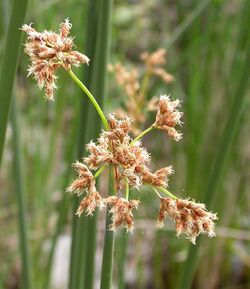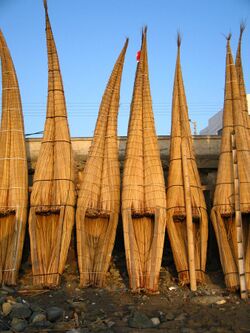Biology:Schoenoplectus californicus
| Schoenoplectus californicus California bulrush | |
|---|---|

| |
| Inflorescence | |
| Scientific classification | |
| Kingdom: | Plantae |
| Clade: | Tracheophytes |
| Clade: | Angiosperms |
| Clade: | Monocots |
| Clade: | Commelinids |
| Order: | Poales |
| Family: | Cyperaceae |
| Genus: | Schoenoplectus |
| Species: | S. californicus
|
| Binomial name | |
| Schoenoplectus californicus (C.A. Mey.) Steud.
| |
| Synonyms[1] | |
| |
Schoeneoplectus californicus is a species of sedge known by the common names California bulrush,[2] southern bulrush and giant bulrush. It is also sometimes called "tule", but the closely related Schoenoplectus acutus is the species most often referred to by that name.
Description
Schoenoplectus californicus is a rhizomed water plant found in marshy areas. It is native to the southern and western United States as well as Mexico, Central America, South America, Easter Island, and the Falkland Islands. It is naturalized on some Pacific islands including New Zealand, Hawaii and the Cook Islands.[1][3][4][5] It has tall, thin, dark green stems which are usually triangular in cross-section and woolly, bristly tan or brown flowers in panicle inflorescences.[6][7]
Uses
A notable subspecies is the totora, Schoenoplectus californicus subsp. tatora. This is famous for making up the floating islands on which the Uros people of Lake Titicaca dwell, as well as occurring on isolated Easter Island in the Pacific.[8]
Boats have also been made from this plant by many cultures, including the Caballito de totora in Peru for over 3,000 years. The plants are still farmed in wetlands next to the sea for the boats, and there is also an ecological reserve that specifically protects these sedge farms called the Swamps of Huanchaco.[9]
References
- ↑ 1.0 1.1 Kew World Checklist of Selected Plant Families
- ↑ "Schoenoplectus californicus". Natural Resources Conservation Service PLANTS Database. USDA. https://plants.usda.gov/core/profile?symbol=SCCA11.
- ↑ Biota of North America Program, 2013 country distribution map
- ↑ Adams, C. D. 1994. 17. Schoenoplectus (H.G. Reichb.) Palla. 6: 449–450. In G. Davidse, M. Sousa Sánchez & A.O. Chater (eds.) Flora Mesoamericana. Universidad Nacional Autónoma de México, México, D. F.
- ↑ Forzza, R. C. 2010. Lista de espécies Flora do Brasil http://floradobrasil.jbrj.gov.br/2010. Jardim Botânico do Rio de Janeiro, Rio de Janeiro
- ↑ Jepson Interchange: Schoenoplectus californicus
- ↑ Gonzalez. 2007. Sinopsis de Scirpus s.l. (Cyperaceae) para México. Acta Botánica Mexicana 82: 15–41.
- ↑ Charles Heiser. 1978. The Totora (Scirpus Californicus) in Ecuador and Peru. Economic Botany July–September 1978, Volume 32, Issue 3, pp 222-236
- ↑ "(spanish) Swamps of Huanchaco". http://caballitodetotora.tripod.com/totorales/pantanos.pdf.
External links
Wikidata ☰ Q1759331 entry
 |



